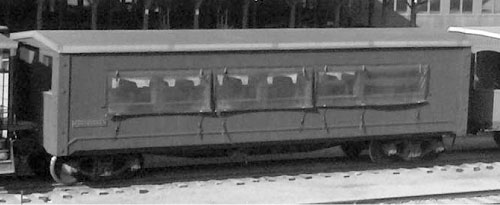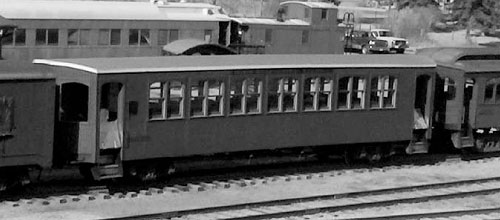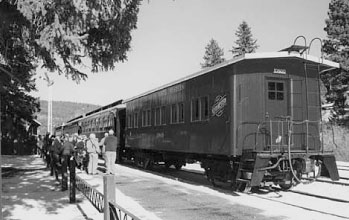Rolling Stock Restoration
Locomotives & Passenger Cars
An interesting combination of locomotives, passenger, freight and maintenance cars have called Hill City home since the 1950s, and many of them are still here for you to enjoy. The following pages provide information on the Black Hills Central's (BHC) locomotives and passenger equipment, as well as details about other rolling stock that you will see at Hill City.
Steam Locomotive #7

The "Seven" was sold to the Prescott and Northwestern in Northern Arkansas in 1938 and was acquired by the BHC in 1962. Built in 1919, this 2-6-2 steam engine is over 100 years old! It is featured now on static display at the Hill City property, but has served as the face of the company for many years. The locomotives features have been altered from its original builders photo, primarily due to its appearance in a number of Hollywood productions through the years. “Gunsmoke”, CBS’s production of “Orphan Train”, and the Steven Spielberg 2005 mini-series “Into the West”
Steam Locomotive #104

Number 104 is a 2-6-2T tank engine that was built by Baldwin Locomotive Works in 1926 for the Silver Falls Timber Company in Oregon and The Peninsula Terminal Railroads in Portland, Oregon. The BHC acquired #104 and its twin number #103 (built in 1922) in 1965. Number 104 has been in continuous service over the years. Number 103 is currently in storage awaiting restoration.
Steam Locomotive #110

This is a 2-6-6-2T articulated Mallet that was built by The Baldwin Locomotive Works in 1928 for the Weyerhaeuser Timber Company of Vail, WA. Its next stop was The Rayonier Lumber Company where it received a tender from Rayonier #101 and was retired in 1968. This engine was later displayed at the Wasatch Mountain Railway in Heber City, UT, and then sold to the Nevada State Railway Museum. The #110 was sold to The BHC in 1999 and was trucked from Nevada to South Dakota on four semi-trailers. Restoration on this engine was completed in the spring of 2001. It is the only 2-6-6-2T Mallet in service in the world.
Steam Locomotive #108

Locomotive #108 joined its nearly identical twin, #110, at the beginning of the 2020 season following a four-year restoration. This 2-6-6-2T articulated tank engine was built by the Baldwin Locomotives Works in 1926 for the Potlatch Lumber Company. It later made its way to Weyerhaeuser Timber Company and eventually to the Northwest Railway Museum in Snoqualmie, Washington.
The acquisition and subsequent restoration of locomotive #108 completed a more than 20-year goal of increasing passenger capacity which began with the restoration of #110 and the restoration of multiple passenger cars. Both large Mallet locomotives (pronounced “Malley”) can pull a full train of seven authentically restored passenger cars, up from the four cars utilized prior to their addition to the roster.
At first glance the #108 and #110 appear to be identical twins, but they do have a few distinct visual differences. The most significant visual cue is the large blue water tank the Fireman fills from the water tower prior to each departure. #108 has a full saddle tank which completely covers the boiler, while the tank on #110 is split into two halves with a slight gap at the top. The difference is subtle, but #108’s tank is slightly narrower than #110, providing the Engineer a slightly better forward view. While both locomotives share near identical designs, our Railroad Operations crews tell us they each have their own unique personalities and challenges to operate.
Diesel Locomotive #1

Number 1 is a 1940-vintage Whitcomb diesel locomotive. This engine was built for the Department of Defense and was operated in Washington State during World War II. It was then purchased for switching at the Black Hills Power and Light coal-fired generating plant near Lead, SD. The #1 was acquired in 1983 and is used for switching duties on the BHC.
Diesel Locomotive #63

Number 63 is a GP9 model diesel built by the Electro-Motive Division of General Motors for the Chesapeake and Ohio Railroad as #6178 in November of 1956 (builder number 22561). The unit was renumbered to #63 when purchased by the Indiana and Ohio Railroad and retained that same number during subsequent sales to the Northeast Kansas and Missouri Railroad, Chillicothe-Brunswick Railroad and Progressive Rail, Incorporated.
Locomotive #63 now sports a distinctive crimson and black paint scheme and proudly leads all of our wintertime Holiday Express train departures. #63 also serves as the reserve locomotive in summertime in the event we have a mechanical issue on our steam locomotives.
Coach #65, Edward Gillette

Edward Gillette, named after an engineer who was the track locator for the High Line Route from Edgemont to Deadwood, was originally a combine car used on the Oregon Electric Railway. Car #65 has been at the 1880 Train since it was purchased in the 1970s. It was restored to its original glory in 2009. Edward Gillette accommodates 48 passengers with style. The car features several hard woods throughout its interior along with stained and frosted glass windows and upholstered seats.
Coach #112, Oreville; Coach #125, Keystone; Coach #133, Addie Camp

Coaches #112 Oreville, #125 Keystone and #133 Addie Camp were originally part of a series of interurban passenger equipment built by the American Car Company for the Oregon Electric Railway in 1913. Some of the equipment from this series was, in turn, sold to the Pacific Great Eastern Railway in British Columbia, Canada, where they were used until the mid-1960s. The BHC purchased the #112, #125, #133, #140, #144 and several other cars in the early 1970s.
These passenger cars are the mainstay of the Black Hills Central Railroad, with interiors richly restored to their more than 100-year old glory. Oreville was completely restored by the Black Hills Central staff in 1997 and serves as the location of our onboard narration Host. Keystone was returned to service after its complete restoration in 2004.
Addie Camp is one of the original passenger car restorations of the Black Hills Central and was a workhorse for many years. In a unique twist, Addie Camp now serves as a one-of-a-kind restaurant in Soldotna, Alaska—still proudly bearing her Black Hills Central Railroad markings far from her home rails! https://www.whistlehillsoldotna.com/
Coach #144, Redfern

Coach #144 Redfern was originally built as a baggage car. The Oregon Electric Railway converted it to a passenger coach in 1915. The BHC modified the coach for use as an open observation car in 1998, for better viewing of the beautiful Black Hills scenery.
Coach #140, Mystic

A former Oregon Electric Railway passenger coach was rebuilt into an open observation car in 1999. The car's appearance is much like the ones used by the Rapid City, Black Hills and Western Railroad in the 1920s between Rapid City and Mystic.
Coach #91, Rochford

Coach #91 Rochford is a product of the fine workmanship here at the BHC. It was used as a car to carry ice and water for the track crews. It now provides a comfortable ride for 52 passengers.
Coach - Harney Canyon

Please take a close look at the craftsmanship and detail of Harney Canyon. It was a former Chicago, Burlington and Quincy wooden caboose, but very little was salvageable when the crew disassembled the car in 2006. The car was then rebuilt to look much like the railroad's other former interurban coaches with a pleasing combination of pine, poplar and oak materials.
Coach - Bluebird

New on the rails in 2006, the Coach Bluebird began life as a Chicago, Burlington and Quincy flat car. The BHC’s car shop crew transformed the bare frame into a comfortable 50-seat coach with the use of a pine structure and an attractive knotty pine interior, which is representative of the beautiful Black Hills forests.
Drovers Waycar #10800, Hillyo

Coach #10800 Hillyo is one of the most interesting cars used by the Chicago and North Western Railway as a Drovers Waycar. Drovers cars were used ahead of the regular way car (commonly referred to as a caboose) by ranchers and stockowners that accompanied their cattle during shipment to market. The BHC shop restored the #10800 for use in 1998. Only two of these cars still exist in the United States.
Coach, High-Liner Snack Shoppe

These two steel cars are World War II-era heavyweight hospital cars. They were acquired from the Igloo Army Depot near Edgemont, SD, and have been at the BHC since the 1960s. The cars are now used as the High-Liner Snack Shoppe and a museum exhibition display car.
The Burlington Northern caboose #10866 was originally a Northern Pacific Railroad caboose built in 1906. It is coupled to the end of the heavyweight High-Liner Snack Shoppe and display cars at Hill City.

 Learn more about all of our train cars in the 1880 Train Guide Book! It's available at our gift shops in Hill City and Keystone.
Learn more about all of our train cars in the 1880 Train Guide Book! It's available at our gift shops in Hill City and Keystone.